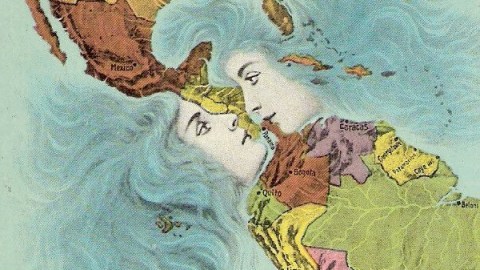Sign up for Big Think on Substack
The most surprising and impactful new stories delivered to your inbox every week, for free.
These postcards of two oceans kissing were popular at the time of the opening of the Panama Canal, in 1914. The completion of that waterway was a huge achievement, and a costly undertaking in both lives lost and money spent. As an engineering feat, it still rates as one of the wonders of the modern world.
As early as 1534, king Charles V of Spain suggested a canal in Panama across the Central American isthmus. Even with the primitive state of cartography of the day, it wasn’t hard to see how such a canal would facilitate trade and travel by eliminating the lengthy, dangerous shipping route rounding Cape Horn.
One of the last acts of the independent Kingdom of Scotland was the ill-fated Darien Scheme, an attempt at setting up a colony on the isthmus, that would live off the overland trade route between Panama’s Pacific and Atlantic shores. Thousands died and the scheme’s collapse in 1700 is thought to have contributed to the Act of Union (1707), establishing the United Kingdom.
The Panama Railway, opened in 1855, was a more successful reprise of the same idea, and eventually led to the creation of the Panama Canal. The initially French scheme, headed by Ferdinand de Lesseps (of later Suez Canal fame – see also #617) was quite literally plagued by malaria and yellow fever, to such an extent that it was abandoned in 1893, after 13 arduous, lethal years. Some 22.000 workers had died.
The US undertook a second, more successful attempt at canal-digging from 1904 to 1914, completing the canal two years ahead of schedule and at a greatly smaller cost in human lives (‘only’ 5.600 died). The US retained sovereignty and control of the Panama Canal Zone – incidentally, Guantanamo Bay was ‘leased in perpetuity’ from Cuba to protect the trade routes to and from the Canal. By a 1977 treaty with the US, Panama gained control over the Canal Zone on New Year’s Eve, 1999.
Some interesting Panama Canal stats and facts:
Before the official opening of the canal on August 15, 1914, a ship sailing from New York to San Francisco would have had to travel (14,000 milies (22,500 km) before 1914, going all the way around Cape Horn. The canal more than halved the journey.The Atlantic and Pacific oceans were joined on October 10, 1913, by an explosion triggered by a telegraph sent by President Woodrow Wilson from the White House. On August 3, 1914, the SS Cristobal was the first ship to pass from one ocean to the other via the canal.The canal is 48 miles (77 km) long, and runs from northwest on Panama’s Atlantic shore to southeast on its Pacific coast. A passage through the canal takes six to eight hours. Annual traffic rose from around 1,000 ships in 1914 to well over 14,000 in 2008.The canal had cost the U.S. about $375 million ($8.6 billion in today’s money) to complete. The U.S. held on to the Panama Canal Zone until 31 December 1999, when it was handed over to Panamanian control.The original locks were 94 feet (28.5 m) wide, later widened to 110 feet (33.5 m). This limited the maximum width of ships passing through (a.k.a. ‘Panamax’) before the completion of new locks in 2016, allowing for ‘post-Panamax’ ships to go through the canal, now 180 feet (55 m) wide.Barro Colorado Island, the largest island in Gatun Lake, through which the canal passes, is administered by the Smithsonian Institution for research into tropical ecology.The highest toll ever paid by a cruise ship was $375,600, by the Norwegian Pearl on April 14, 2010. The lowest toll ever was 36 cents, in 1928 by Richard Halliburton, the American travel writer and adventurer who swam the length of the canal.In 2015, the canal handled 340 million tons of shipping, more than four times the maximum of 80 million tons, as estimated in 1934.In 2013, Nicaragua awarded a Chinese group a 50-year concession to develop a rival canal through the country. Construction began in December 2014 and was projected to take five years.Strange Maps #188
Got a strange map? Let me know at strangemaps@gmail.com.
Sign up for Big Think on Substack
The most surprising and impactful new stories delivered to your inbox every week, for free.










